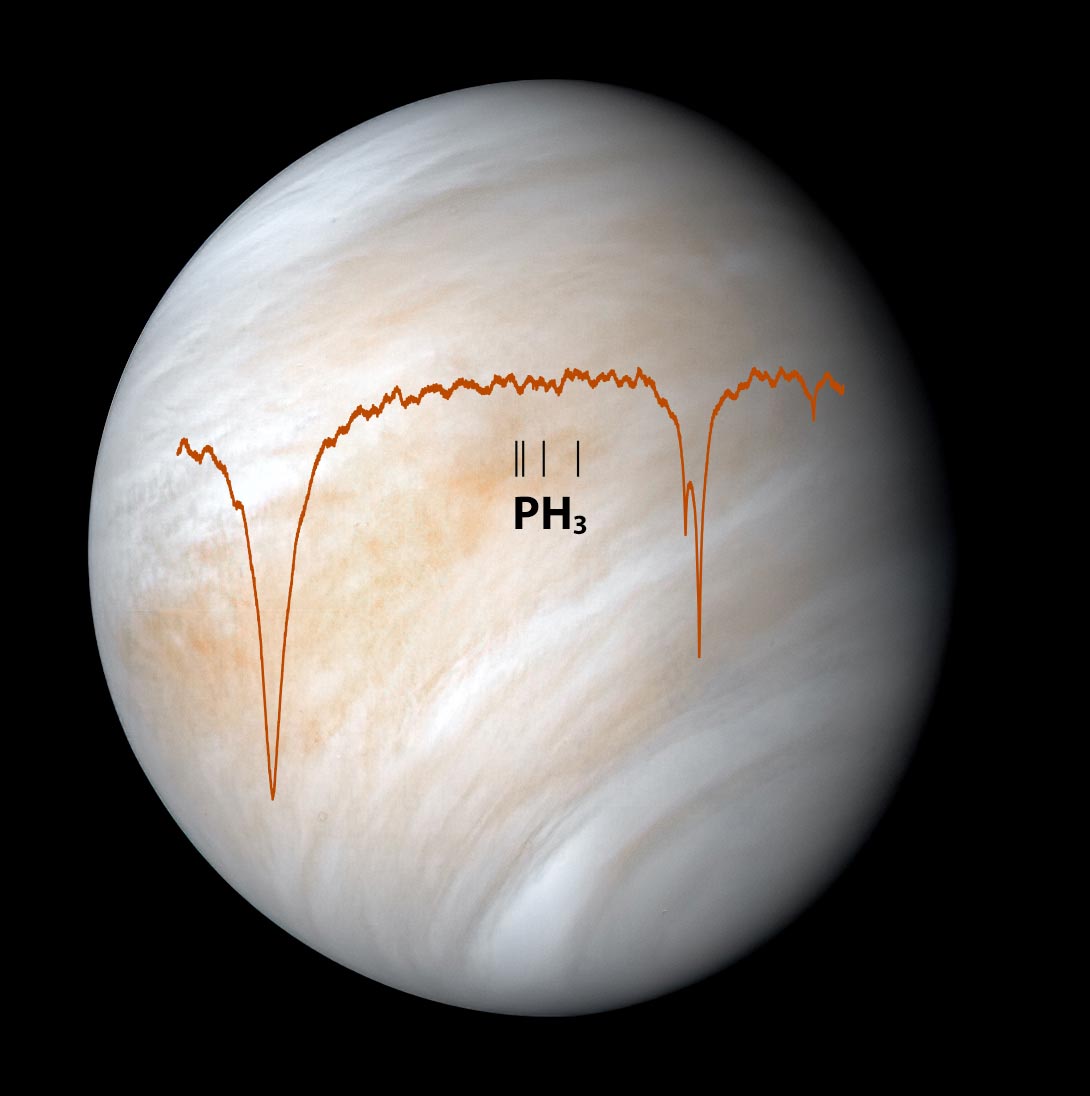The spectral data from SOFIA overlain atop this image of Venus from NASA’s Mariner 10 spacecraft is what the researchers observed in their study, showing the intensity of light from Venus at different wavelengths. If a significant amount of phosphine were present in Venus’s atmosphere, there would be dips in the graph at the four locations labeled “PH3,” similar to but less pronounced than those seen on the two ends. Credit: Venus: NASA/JPL-Caltech; Spectra: Cordiner et al.
Venus is considered Earth’s twin in many ways. However, recent observations made with the Stratospheric Observatory for Infrared Astronomy (SOFIA) have now made one difference clearer: Unlike Earth, Venus does not have any obvious phosphine.
Phosphine is a gas found in Earth’s atmosphere. In 2020, the announcement of phosphine discovered above Venus’s clouds made headlines because it has strong potential as a biomarker. In other words, the presence of phosphine could be an indicator of life. Although it is common in the atmospheres of gas planets like Jupiter and Saturn, phosphine on Earth is associated with biology. On our planet, it’s formed by decaying organic matter in bogs, swamps, and marshes.
“Phosphine is a relatively simple chemical compound — it’s just a phosphorus atom with three hydrogens — so you would think that would be fairly easy to produce. But on Venus, it’s not obvious how it could be made,” said Martin Cordiner, a researcher in astrochemistry and planetary science at NASA’s Goddard Space Flight Center in Greenbelt, Maryland.
There may be other potential ways to form phosphine on a rocky planet, like through lightning or volcanic activity, but none of these apply if there simply isn’t any phosphine on Venus. And according to SOFIA, there isn’t.
Following the 2020 study, a number of different telescopes conducted follow-up observations to confirm or refute the finding. Cordiner and his team followed suit, using SOFIA in their search.

An Armstrong F/A-18 flying safety and photo chase for NASA’s SOFIA 747. SOFIA achieved full operational capability in 2014 and concluded its final science flight on September 29, 2022. Credit: NASA / Jim Ross
The recently retired SOFIA was a telescope on an airplane and, over the course of three flights in November 2021, it looked for hints of phosphine in Venus’s sky. Thanks to its operation from Earth’s sky, SOFIA could perform observations not accessible from ground-based observatories. Its high spectral resolution also enabled it to be sensitive to phosphine at high altitudes in Venus’s atmosphere, about 45 to 70 miles (about 75 to 110 kilometers) above the ground — the same region as the original finding — with spatial coverage across Venus’s entire disk.
No sign of phosphine was found by the researchers. According to their results, if there is any phosphine present in Venus’s atmosphere at all, it’s a maximum of about 0.8 parts phosphine per billion parts of everything else, which is much smaller than the initial estimate.
Pointing SOFIA’s telescope at Venus was a challenge in and of itself. The window during which Venus could be observed was short, about half an hour after sunset, and the aircraft needed to be in the right place at the right time. Venus also goes through phases similar to the Moon, making it difficult to center the telescope on the planet. Add in its proximity to the Sun in the sky — which the telescope must avoid — and the situation quickly became tense.
“You don’t want sunlight accidentally coming in and shining on your sensitive telescope instruments,” Cordiner said. “The Sun is the last thing you want in the sky when you’re doing these kinds of sensitive observations.”
Despite the fact the group did not find phosphine after the stressful observations, the study was a success. Along with complementary data from other observatories that vary in the depths they probe within Venus’s atmosphere, the SOFIA results help build the body of evidence against phosphine anywhere in Venus’s atmosphere, from its equator to its poles.
SOFIA was a joint project of NASA and the German Space Agency at DLR. DLR provided the telescope, scheduled aircraft maintenance, and other support for the mission. NASA’s Ames Research Center in California’s Silicon Valley managed the SOFIA program, science, and mission operations in cooperation with the Universities Space Research Association, headquartered in Columbia, Maryland, and the German SOFIA Institute at the University of Stuttgart. The aircraft was maintained and operated by NASA’s Armstrong Flight Research Center Building 703, in Palmdale, California. SOFIA achieved full operational capability in 2014 and concluded its final science flight on September 29, 2022.
Share your story or advertise with us: Whatsapp: +2347068606071 Email: info@newspotng.com












